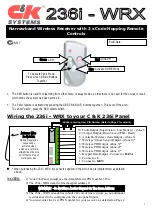
Remote Control
R&S
®
ESR
574
User Manual 1175.7068.02 ─ 12
block overlapped execution of the command. Append the synchronization command to
the overlapping command, for example:
SINGle; *OPC?
For time consuming overlapped commands, you can allow the controller or the instru-
ment to do other useful work while waiting for command execution. Use one of the fol-
lowing methods:
*OPC with a service request
1. Set the OPC mask bit (bit no. 0) in the ESE: *ESE 1
2. Set bit no. 5 in the SRE:
*SRE 32
to enable ESB service request.
3. Send the overlapped command with
*OPC
.
4. Wait for a service request.
The service request indicates that the overlapped command has finished.
*OPC? with a service request
1. Set bit no. 4 in the SRE:
*SRE 16
to enable MAV service request.
2. Send the overlapped command with
*OPC?
.
3. Wait for a service request.
The service request indicates that the overlapped command has finished.
Event status register (ESE)
1. Set the OPC mask bit (bit no. 0) in the ESE:
*ESE 1
2. Send the overlapped command without
*OPC
,
*OPC?
or
*WAI
.
3. Poll the operation complete state periodically (with a timer) using the sequence:
*OPC; *ESR?
A return value (LSB) of 1 indicates that the overlapped command has finished.
11.1.6
Status Reporting System
The status reporting system stores all information on the current operating state of the
instrument, and on errors which have occurred. This information is stored in the status
registers and in the error queue. Both can be queried via GPIB bus or LAN interface
(
STATus
... commands).
11.1.6.1
Hierarchy of Status Registers
●
STB, SRE
The STatus Byte (
STB
) register and its associated mask register Service Request
Enable (
SRE
) form the highest level of the status reporting system. The
STB
pro-
Remote Control - Basics
















































